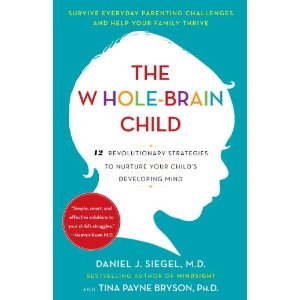 I just started reading the The Whole Brain Child by Daniel J. Siegel, M.D. and Tina Payne Byrson, Ph.D. The sub-title states that it is twelve revolutionary strategies to nurture your child’s developing mind.
I just started reading the The Whole Brain Child by Daniel J. Siegel, M.D. and Tina Payne Byrson, Ph.D. The sub-title states that it is twelve revolutionary strategies to nurture your child’s developing mind.
I won’t pretend that I’m a brain expert or even good at explaining the brain, but I like what I’ve read in Chapter 1 “Parenting with the Brain in Mind:”
“What molds are brains? Experience…It means that we aren’t held captive for the rest of our lives by the way our brain works at this moment…Genes, of course, play a large role in how people turn out, especially in terms of temperament…parents have much they can do to provide the kinds of experiences that will help develop a resilient, well-integrated brain…An integrated brain results in improved decision making, better control of body and emotions, fuller self understanding, stronger relationships, and success in school.”
Honestly, I felt relief that I didn’t cause Elise’s temperament, but at the same time, there’s probably much I have done to influence how she handles herself through out day. Thankfully how Elise has learned to relate to the world can be influenced by experiences; she can learn. And I can learn how to better nurture her developing mind, too; we don’t have to feel stuck (held captive) to our current experiences. To help me and Elise on this journey, the authors talk about navigating the waters between chaos and rigidity:
“So one extreme is chaos, where there’s lack of control. The other extreme is rigidity, where there’s too much control, leading to a lack of flexibility and adaptability. We all move back and forth between these two banks as we go through our days – especially as we’re trying to survive parenting. When we are closest to the banks of chaos or rigidity, we’re farthest from mental and emotional health.”
I think we have definitely experienced some days where we were far from emotional and mental health. So as we enter into the summer days that were very trying for us last summer, I am thankful to have a book that will help me navigate the waters between chaos and rigidity. Here’s to hoping we all end the summer in good mental and emotional health!




